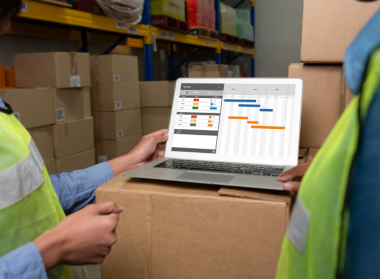If you’re involved in manufacturing, you’re likely familiar with a bill of materials or BOM.
But what exactly is a BOM and why is it so important to create a BOM for your manufactured products?
What Is a Bill of Materials (BOM)?
A bill of materials, usually referred to as a BOM is a comprehensive list of raw materials, parts, components, and their quantities needed to manufacture a new product or repair an existing product.
The BOM also includes complete instructions on the procurement of these materials, along with complete product assembly.
A BOM typically lists the completed product at the top, followed by the materials and components needed, and should include the following information:
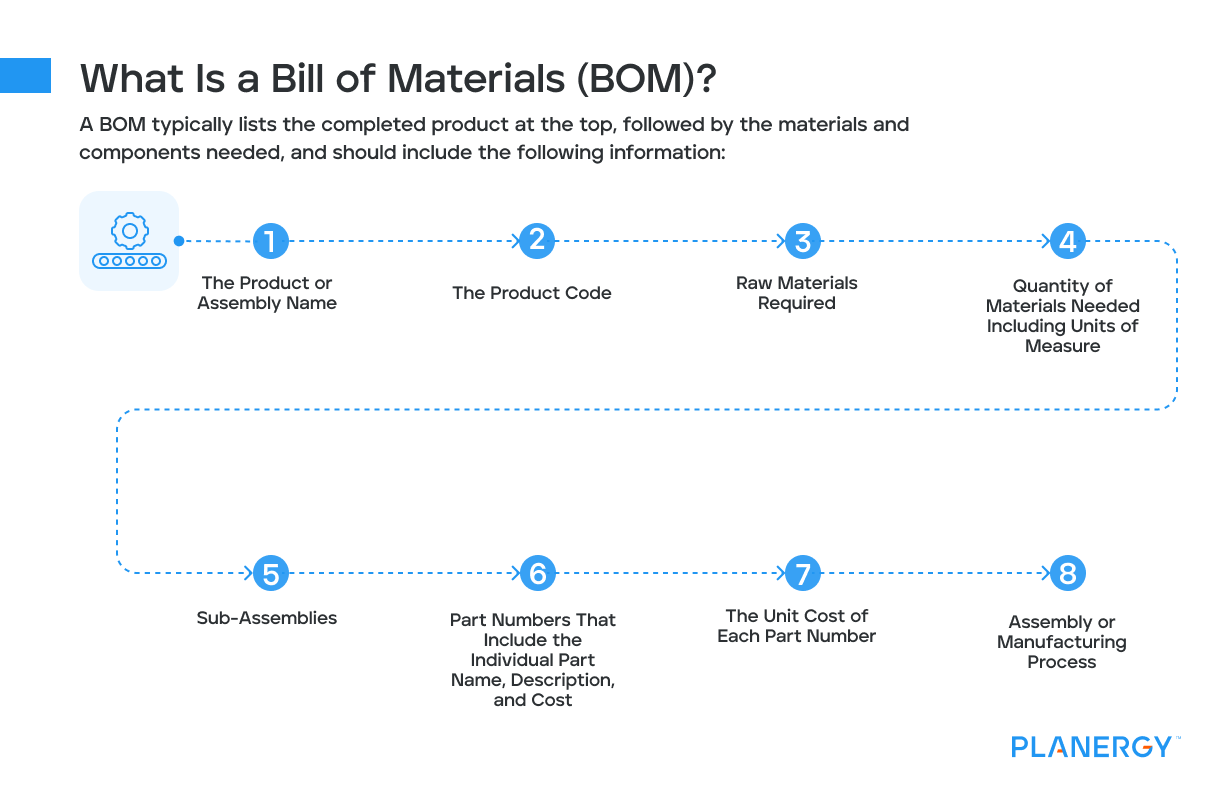
- The Product or Assembly Name
- The Product Code
- Raw Materials Required
- Quantity of Materials Needed Including Units of Measure
- Sub-Assemblies
- Part Numbers That Include the Individual Part Name, Description, and Cost
- The Unit Cost of Each Part Number
- Assembly or Manufacturing Process
The assembly process always begins with the creation of a bill of materials.
Single-Level vs. Multi-Level Bill of Materials
The manufacturing process differs from business to business, depending on the type of product manufactured, the level of detail required to complete the manufacturing process, and the product development phase.
To make sure that the BOM prepared is complete, companies can choose to use either a single-level bill of materials or a multi-level bill of materials.
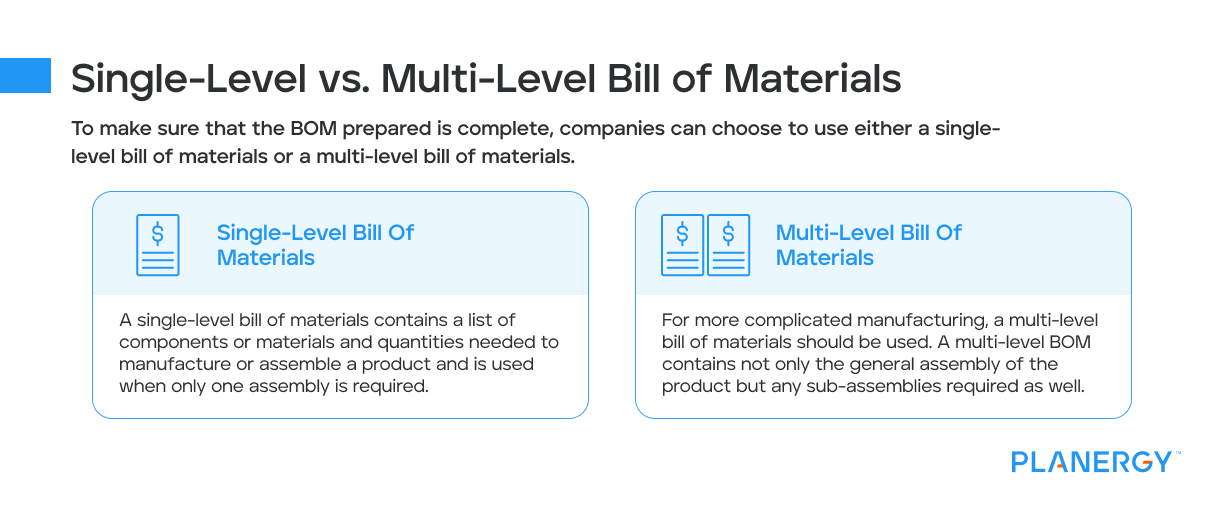
Single-Level Bill of Materials
A single-level bill of materials contains a list of components or materials and quantities needed to manufacture or assemble a product and is used when only one assembly is required.
Multi-Level Bill of Materials
For more complicated manufacturing, a multi-level bill of materials should be used.
A multi-level BOM contains not only the general assembly of the product but any sub-assemblies required as well.
Types of BOMs
Businesses can choose from several different types of bills of materials, depending on the product that is being manufactured and the level of information desired.
Engineering Bill of Materials (EBOM)
An engineering bill of materials is created during the product design phase and is used to define the finished product based on its original design.
An EBOM should include all items, parts, components, materials, and subassemblies required to complete the product and is typically prepared by the product engineer.
An engineering BOM often includes a technical drawing using computer-aided design or CAD to create the finished product and may also include drawings of any related parts and components.
Manufacturing Bill of Materials (MBOM)
A manufacturing bill of materials (MBOM) is always used during the product production phase, identifying materials, parts, components, and assemblies needed to produce a final product.
A manufacturing BOM includes details of the parts needed at each level of assembly, ensuring that the correct parts and components have been ordered before each stage of the assembly begins, which helps companies meet production deadlines.
Configurable Bill of Materials
For highly configurable products, the configurable BOM is used once the product is completed and is ready to be configured for a customer.
For example, if you’re assembling a computer and the customer requests additional memory, once the computer has been assembled, the additional memory will be added.
The configurable BOM also includes any labeling or packaging requirements necessary to fulfill the customer’s requirements.
Production Bill of Materials
A production BOM focuses more on the manufacturing process.
While a production BOM includes a list of all necessary parts and components, it also provides greater detail on the manufacturing process itself, including step-by-step manufacturing instructions.
Sales Bill of Materials
A sales BOM or SBOM provides a list of parts and components required to complete a product as ordered by a customer.
This information is garnered from a customer sales order and should include both the finished product and all the necessary parts and components.
Assembly Bill of Materials
Assembly BOMs include the parent or completed item, manufacturing details, and other production information such as labor and equipment used during the assembly process.
Bill of Materials Example
A bill of materials can be simple or complex, depending on the finished product. For example, if the finished product is a table, the BOM will be single-level.
However, if you’re manufacturing a computer, you’ll need to create a multi-level BOM to cover both the general assembly as well as any sub-assemblies such as a hard drive.
If you’re not manufacturing the hard drive yourself and purchase it already completed, it would simply be another component.
In that case, you could choose to use a single-level bill of materials, which is sufficient for products that don’t require multiple sub-assemblies or if the components are purchased pre-assembled.
For example, a bicycle manufacturer would include all of the parts needed to assemble a bicycle that is ready for purchase including the frame, the seat, the pedals, the handlebars, the brakes, wheels, tires, and chains.
Because all of the parts needed to assemble the bicycle are purchased already assembled, the manufacturer would not need to add any sub-assemblies to their BOM.
However, if you’re an airplane manufacturer, you would need to prepare a multi-level BOM which would include multiple assemblies for the various parts of the plane that need to be assembled including the fuselage, wings, engine, and even the landing gear.
Benefits of BOM Manufacturing
Creating an accurate BOM offers several benefits for manufacturing businesses including:
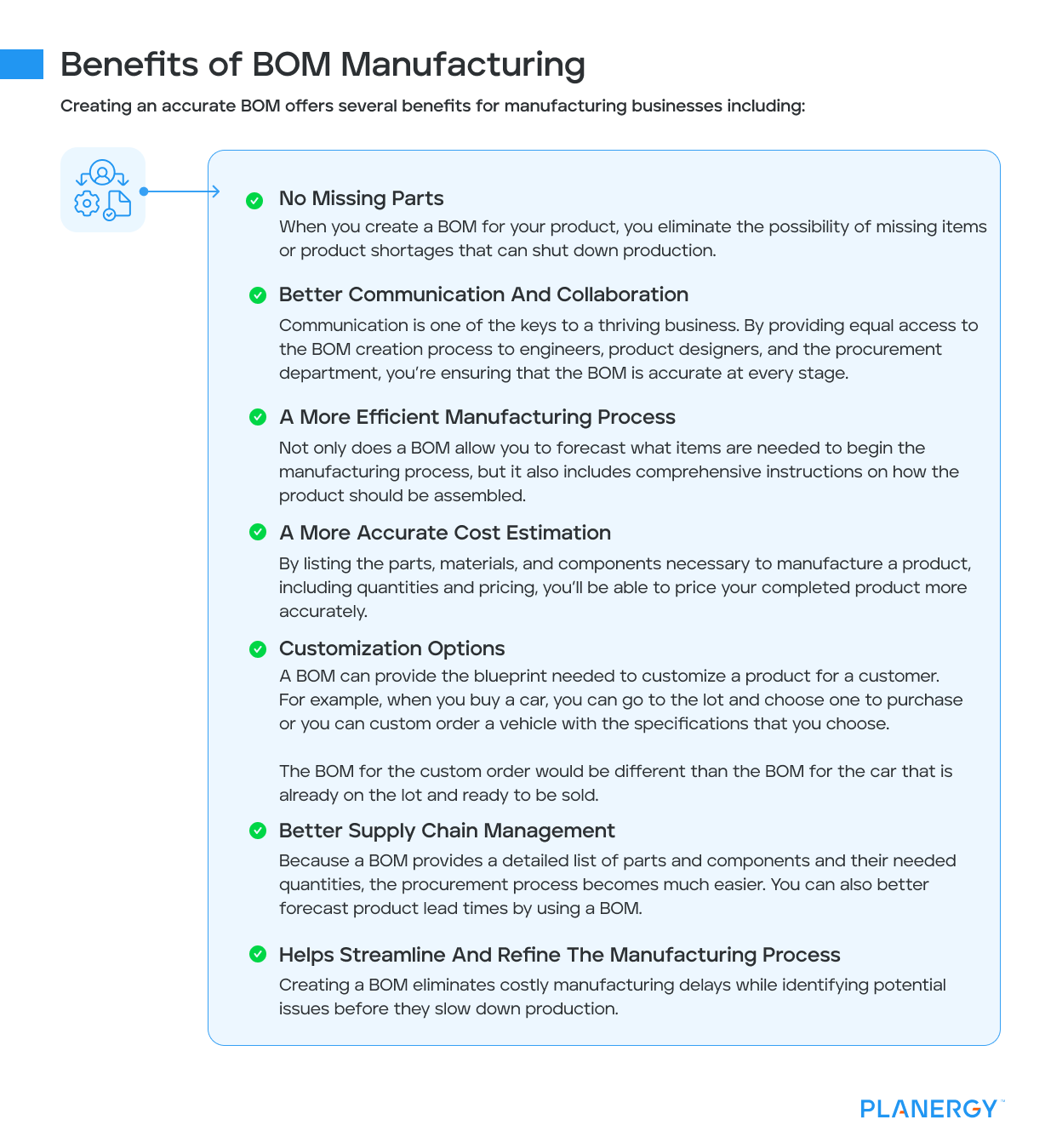
No Missing Parts – When you create a BOM for your product, you eliminate the possibility of missing items or product shortages that can shut down production.
Better Communication and Collaboration – Communication is one of the keys to a thriving business.
By providing equal access to the BOM creation process to engineers, product designers, and the procurement department, you’re ensuring that the BOM is accurate at every stage.
A More Efficient Manufacturing Process – Not only does a BOM allow you to forecast what items are needed to begin the manufacturing process, but it also includes comprehensive instructions on how the product should be assembled.
A More Accurate Cost Estimation – By listing the parts, materials, and components necessary to manufacture a product, including quantities and pricing, you’ll be able to price your completed product more accurately.
Customization Options – A BOM can provide the blueprint needed to customize a product for a customer.
For example, when you buy a car, you can go to the lot and choose one to purchase or you can custom order a vehicle with the specifications that you choose.
The BOM for the custom order would be different than the BOM for the car that is already on the lot and ready to be sold.
Better Supply Chain Management – Because a BOM provides a detailed list of parts and components and their needed quantities, the procurement process becomes much easier.
You can also better forecast product lead times by using a BOM.
Helps Streamline and Refine the Manufacturing Process – Creating a BOM eliminates costly manufacturing delays while identifying potential issues before they slow down production.
Who Creates a BOM?
Who is responsible for creating a BOM can vary from business to business, depending on the type of products being manufactured and the complexity of the process.
In some cases, an engineer or product designer may be responsible for the initial BOM, while purchasing or procurement may be responsible for the BOM moving forward when the product is in production or when completing production orders.
Bill of Materials Management Process
BOM management allows you to create a process that helps you manage the bill of materials process from beginning to end.
One of the most efficient ways to manage the process from initial design to production process, to completed product, is to centralize the entire BOM creation process.
To create accurate BOMs for your business, all relevant departments should have access to the bill of materials as it’s being prepared.
In addition, it’s helpful for outside partners such as vendors and suppliers to have access to the bill of materials as well since they can provide specifications for materials and parts including measurements and unit pricing.
Finally, any changes from the original product design will need to be adequately tracked, with any notes on revisions included in the BOM.
As a live document that is updated frequently, it’s best to use an integrated system that allows the necessary staff to access the BOM at any time.
The BOM process generally follows these steps:
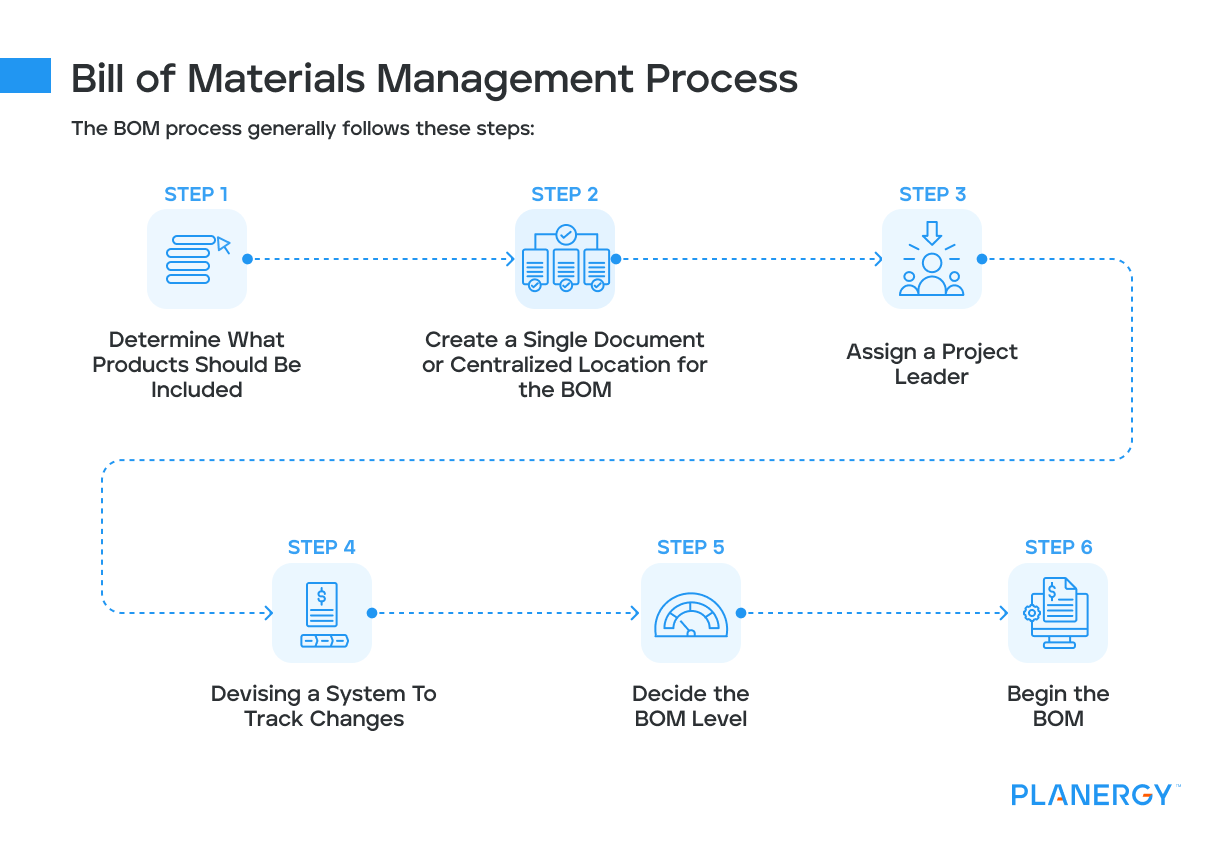
Determine What Products Should Be Included – While this sounds elementary, if a single necessary component is missing on the BOM, it can immediately impact the manufacturing process including deadlines.
Create a Single Document or Centralized Location for the BOM – Multiple departments will likely be involved in the initial BOM creation process, making it essential that the person or persons responsible for creating the BOM have access to all sources.
Assign a Project Leader – A BOM will quickly become a mess when multiple people can make edits and change information.
Assigning a single staff member to handle any edits to the document will eliminate any potential issues.
Devising a System To Track Changes – A BOM will likely change during the creation process.
Be sure to implement a system that tracks any changes to the original document to keep the working document as accurate as possible.
Decide the BOM Level – If you’re building a wood table, you can create a single-level BOM, but an airplane will require a multi-level BOM.
Decide upfront which level is the most appropriate for the products you’re manufacturing.
Begin the BOM – Begin the BOM by listing all necessary parts, materials, and components, and adding and updating the document as needed.
Can You Manage Your BOMs With Excel?
For small businesses and startups, managing BOMs in Excel is a possibility, with Excel templates available from numerous sources.
But as the organization grows the task of keeping the master spreadsheet accurately updated can become difficult.
For instance, when multiple staff members have access to the master spreadsheet, it becomes difficult to know which version of the spreadsheet is the most current.
The error potential is also high using Excel since all data is entered into the application manually, with little oversight.
The best way to manage BOMs is by implementing an automated enterprise resource planning or ERP system that can create both single-level and multi-level BOMs in minutes.
Bills of Material (BOM) in the Supply Chain
Good supply chain management is a necessity for any manufacturing business, regardless of the size and scope of the business.
When products are ordered in the wrong quantity, ordered late, or not ordered at all, the entire production process is interrupted.
To eliminate possible manufacturing stops and stalls, businesses use BOMs to stay on track.
And since a BOM provides a detailed list of all the necessary parts, materials, and components and their quantities for each manufactured product, you can rest assured that your supply chain is working to your advantage while also offering better inventory management capability internally.
BOMs Are a Must for Any Manufacturing Company
Designing and creating a successful product is paramount to a business’s success. But the process can be bumpy if you’re not adequately prepared.
That’s why creating a BOM helps, ensuring that all the necessary parts and components are on hand or ordered, eliminating costly manufacturing delays.
But a BOM also provides step-by-step instructions on how the manufacturing process should be completed, standardizing the entire process from initial BOM to finished product.
Whether you’re manufacturing a simple table or a jet aircraft, creating a BOM is the key to successful product manufacturing.



